The Griggs Building
Introduction
Text-to-speech Audio
Images
Illustration of the Griggs building by artist Betty Bell.
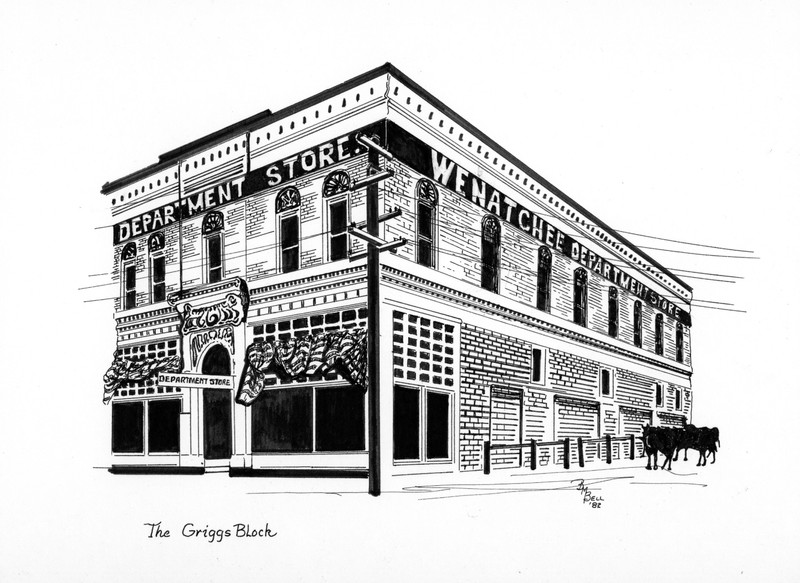
Photo of the Griggs Building in winter. The photo bears a hand written label "1902" but the building wasn't completed until 1903.
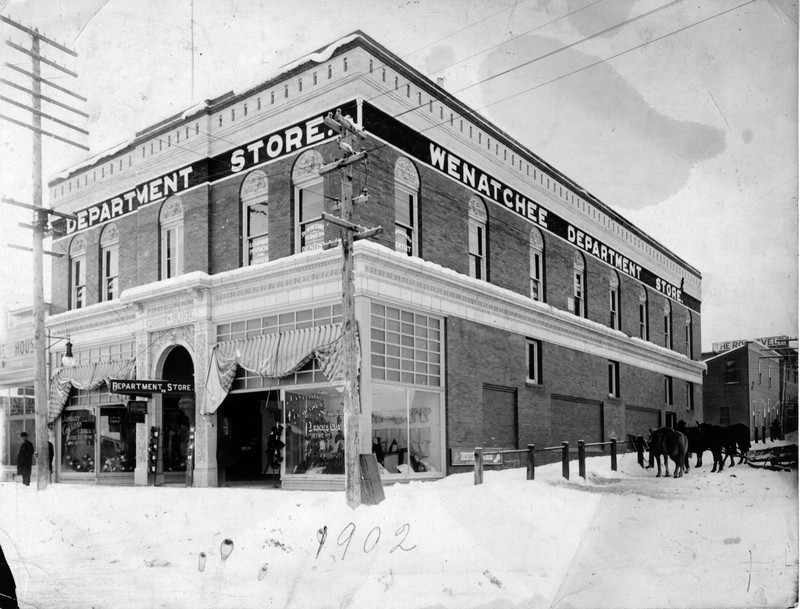
Wenatchee Department Store: Street Level: Walker's. Second story windows: H.A. Saunders, Physician and Surgeon; Dr. Whitaker, Surgeon and Dentist; Doctor Frank Culp. Sign on the stairs: F.F. Keller, Real Estate and Insurance.
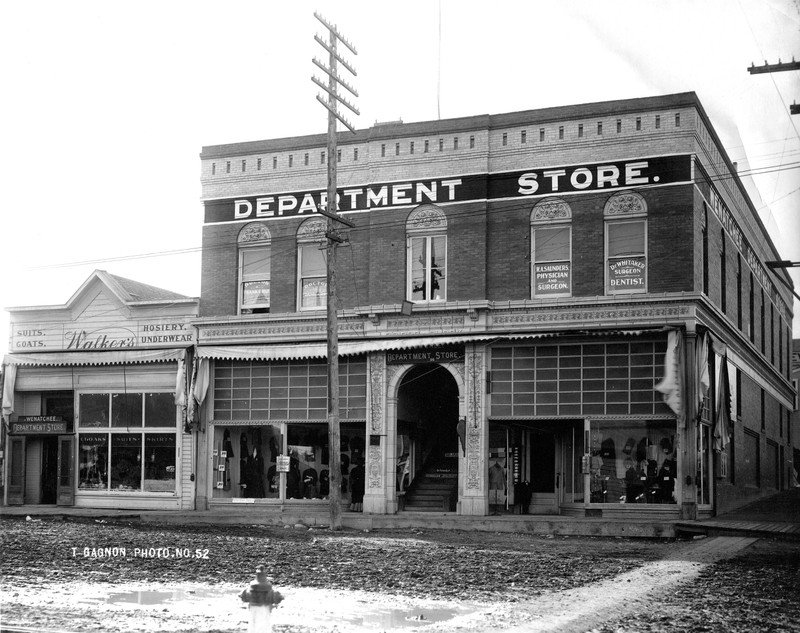
View looking south on Wenatchee Avenue from the intersection with First Street. The Griggs Building with the Wenatchee Department Store on the southwest corner. Many horse drawn wagons and buggies on the dirt roadways. People walking along concrete sidewalks.
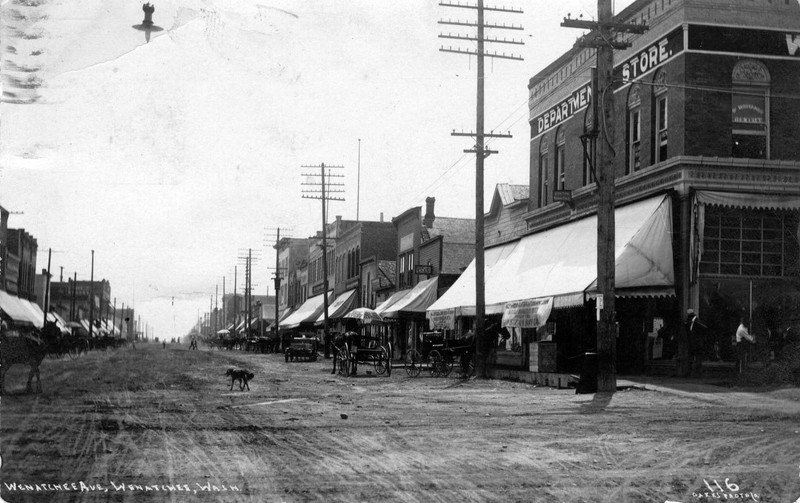
The entrepreneur and steamboat captain Alexander Griggs
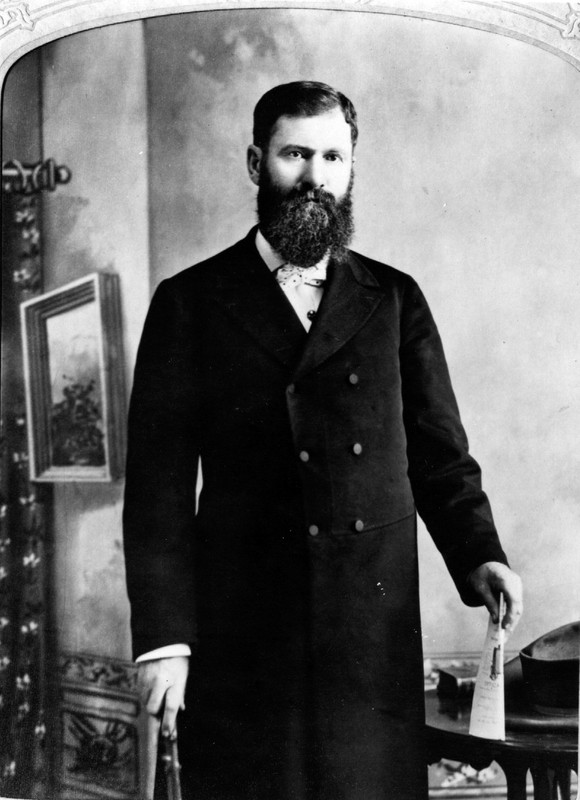
Backstory and Context
Text-to-speech Audio
Alexander Griggs: Wenatchee’s Steamboat Czar
A memorial to Wenatchee’s steamboat era stands at the site of the former Columbia & Okanogan Steamboat Company shipyard at the foot of Fifth Street. The life-sized aluminum statue, a project led by Bill Layman for the North Central Washington Museum (now the Wenatchee Valley Museum & Cultural Center), depicts Captain Alexander Griggs walking to work with a model steamboat tucked under his arm. Griggs may never have carried a toy boat from his home on Fifth and Wenatchee Avenue to the shipyard, or to C & O’s steamboat landing and office a few blocks south, but the image pays homage to a significant community leader during a pivotal 25-year period in NCW history.
Alexander (usually called Alex) Griggs was born Oct. 27, 1838 in Marietta, Ohio. At age 10 he moved with his family to St. Paul, Minn. Rivers were the main transportation highways in those days and, like other boys his age, Alex was drawn to steamboats. He got a job as a cabin boy on an upper Mississippi River steamer at age 13. Once he placed his hands on the great wheel that steered the craft,(IMG: Steamboat Times) he knew he had found his life’s work. By 19 he was licensed as a ship pilot, steering many a steamboat up and down the Mississippi.
Captain Griggs was a tall man with a thick red-brown beard. He was known for his daring and determination, and earned the respect of other river pilots. In 1865 he married Ettie Strong, a 17-year-old Minnesota girl who was an accomplished singer and enjoyed performing in musical theater. The couple eventually had eight children: Lois, Bruce, Ansel, Jennie, Clifford, Esther, James (“Jay”) and Charles, who died in infancy . Of course Ettie supported Alex in his boating life, even when it meant he would be away from home for long periods of time.
One of those periods occurred in the winter of 1870-71. In late November Griggs entered into a race with George Winship down the Red River from Fort Abercrombie, near Fargo, to the newly constructed Fort Pembina, two miles south of the Canadian border. (The Red flows northward, forming the boundary between Minnesota and what was then Dakota Territory and emptying into Lake Winnipeg on the way to Hudson Bay.) Steamboats were not yet in use on the Red, but both men had small fleets of flatboats that were carrying merchandise for the new fort. The Grand Forks Daily Herald later told the story:
It was almost time for the freeze-up and already the river was covered with ice along the banks. Water was low. Winship, who had eight boats and five men, got loaded first, the Captain (Griggs) having five large boats. The latter, however, said he would win the race … as he was familiar with the channel and a good navigator. When Winship’s fleet got to Goose Rapids (ahead of Griggs), the water was only six inches above the rocks and it was a laborious job to cross. Getting over safely with the utmost exertion and exposure, they tied up for the night and went into camp.
It snowed hard that night, and in the morning Winship discovered one of his flatboats had sunk. Its cargo of 40 kegs of ale was floating downstream. He sent some of his men on another boat to recover them. They succeeded in rounding up 39 of the kegs, bringing them back to the camp and continuing north to Pembina. Meanwhile, Griggs’ boats were approaching the rapids. They crossed safely.
But as fate would have it, the tars found the missing keg of ale, it being a legitimate prize which they all prized too highly and they had a high old time. “It broke them all up,” in nautical parlance. As the captain said afterwards, it busted him wide open. The result was there was ale to pay and the captain’s fleet got ice bound…x (Grand Forks Daily Herald, Jan. 1, 1885.)
Founder of Grand Forks, N.D.
The drunken crew pulled over for the night at an uninhabited spot called “Les Grandes Fourches,” a former rendezvous for French fur traders. In the morning they were distressed to see that their boats were solidly frozen in place. They built a log cabin for shelter for the next few months. Griggs became convinced that this site held great potential for a new town and, when the ice thawed and he returned to civilization, he registered a town site claim for Grand Forks.
Around this time Griggs became friends with another pilot, Samuel Clemens/Mark Twain, who was a few years older than him, and with a freight clerk his own age who was later to woo him to Wenatchee. James J. Hill was working for modest pay out of a Mississippi River freight office near St. Paul that was built of splintery, unplaned boards; his desk was nailed to the rough wall. Griggs and Hill decided to build a steamboat of their own to operate on the Red River. Launched in 1871, the Selkirk, named after a Winnipeg-area community on the Red, was just the second steamer to ply that river.
In addition to piloting steamboats, Alex spent the next few years persuading friends and relatives to join him and his family in pioneering a new community. As Grand Forks grew it became an important stop for Red River steamboats carrying furs, wheat and other goods. Griggs formally platted the town in 1875.
Revered as “the father of Grand Forks,” Captain Alexander Griggs saw his little settlement grow from a handful of buildings to a thriving city of 1,800 by 1880. He built a boarding house, hotel, steamboat repair yard, grain mill, sawmill, hotel, churches, saloons and city block of brick buildings to accommodate the city’s growth. Over the years he served as alderman, mayor, postmaster, school board member, real estate man, merchant, banker and boat builder.x (“History of Grand Forks,” und.edu)
For the next several years, while his friend Jim Hill turned his attention to railroads, Griggs continued as a steamboat captain on the Red River. He piloted the Humboldt, Little Dorrit, Aerial, Chippewa Falls, Favorite, Jennie Baldwin, Albany, Otter, Countess, Mankato Otter, St. Anthony Falls, City of St. Paul, Cheyenne, Manitoba, International, Alpha, Dakota, Alsip, Pluck, and his beloved Selkirk.x (Album of Biography of the Famous Valley of the Red River of the North and the Park Regions, 1889; quoted in www.reshapingthetornadobelt.com.) In 1884 the Selkirk struck a railroad bridge at Grand Forks and sank into the Red River. Griggs retrieved the pilot house and took it to his home for his children to use as a playhouse. When he later moved to Wenatchee, he installed the Selkirk’s pilot bell at the front of his house.
The governor of Dakota Territory appointed Griggs to be one of the three new railroad commissioners. The other two elected him chair of the commission. He was also chosen as a delegate to the first North Dakota Constitutional Convention in Bismarck in 1889, and represented North Dakota on a joint constitutional commission with new sister state South Dakota.
Around this time Jim Hill was preparing to extend his regional railroad, the St. Paul, Minneapolis and Manitoba, to the Pacific Northwest. Renamed the Great Northern Railway, it connected St. Paul with Seattle and was extremely influential in attracting settlement along its 1,700-mile route. Hill envisioned the tiny town of Wenatchee, on the Columbia River, someday becoming a commercial hub on the Great Northern line – and he knew that steamboats could be key to this development.
Griggs relocates to Wenatchee
In 1891 Hill persuaded Alex Griggs to leave Grand Forks and invest in a new frontier enterprise. The captain moved his family (including several grown children) to Wenatchee the following year and took charge of the Thomas L. Nixon, the large sternwheeler used by the Great Northern to ferry train cars across the Columbia River until completion of a railroad bridge. (The Nixon could carry six cars at a time; the locomotives were kept on each bank.) Griggs used the boat as an office for the next few years as he worked to amass a larger fleet.
In 1893 Captain Alex bought the Nixon and the smaller City of Ellensburgh. Captain William P. Gray had piloted this craft from Pasco through the treacherous Rock Island Rapids in 1888 and vowed never to navigate those rapids again. From 1888 to 1893 the Ellensburgh had operated at regular intervals between Malaga and Virginia City (now called Brewster).
The original intent of bringing steamboats to this section of the Columbia River had been to carry miners, and equipment that had been hauled from Ellensburg over Colockum Pass to the Malaga area, up to the silver mines of Ruby and Conconully in Okanogan country – and then to transport ore down to Ellensburg. The mines closed after the price of silver plummeted in the Panic of 1893, but settlers kept coming. Wheat growers in Douglas and Okanogan counties, needing transportation to get their crop to market, relied on steamboats to haul the wheat to the Great Northern freight yard in Wenatchee.
Pouncing on this business opportunity, Griggs started what came to be known as the Columbia and Okanogan Steamboat Company. By 1896 he had two centers of operation in Wenatchee: a boat landing at the foot of Chehalis Street to which the Great Northern had extended a spur line for freight loading, and the shipyard at the foot of Fifth Street. He hired other captains, including his oldest son Bruce and a Dane called Claus Hansen, to pilot the Nixon, City of Ellensburgh and newly built Oro.
Griggs bought several pieces of property along the Columbia River as well as, for a time, the Friday (gold) Mine on the Methow River. He entered into an agreement with John Bruster to create a new town just north of Virginia City so his boats could have a better landing site. Brewster, the upper port of Griggs’ mini empire, became the stopover for passengers and freight transferring to boats headed north on the Okanogan River. The Gamble Hotel in Brewster did a brisk business despite reports of bedbugs.
A challenging river
Compared to the sluggish Red River, the Columbia was an exciting river on which to pilot a steamboat. It had strong currents, eddies, whirlpools and several rapids where boats occasionally came to grief. Dorothy Tibbets, in “Reminiscences of a Ranch Woman,” describes an 1895 trip on the Ellensburgh along with Ettie and Alex Griggs. Three of the Griggs sons and one daughter were also onboard, with son Bruce at the helm. They were on deck as the steamer approached the Entiat Rapids. Ascending these required “lining” – tying ropes from the steamboat to rocks onshore while someone temporarily affixed a metal cable to a ring solidly embedded in rock upstream.
Just the first streaks of dawn coming over a desolate looking plateau to the east, the wheat-land of the “Big Bend” country. To the west the frowning mountains, and ahead jagged rocks, almost filling the river bed, some towering several times higher than the smoke stack of the boat, while around the submerged ones, the swollen waters of the Columbia made whirlpools only surpassed by those below Niagara Falls. A narrow passage of comparatively smooth water, close to the eastern bank, showed where the boat must keep a perfectly straight course to avoid the rocks. This was only possible by carrying a cable, attached to the winch on the forward deck, up to the giant rings which the government had already anchored securely in large boulders. By fastening it safely there, then, with the donkey engine turning the winch and slowly winding up the cable, the boat would not only be kept on her course, but her engines assisted in carrying the load up against the strong current.
A crew member stretched out the cable along the bank and hooked it to the ring. The donkey engine and the main propelling engine started up. Bruce Griggs shouted to the two men who had tied the temporary stabilizing ropes, “Cut the lines!”
The man at the stern line severed the heavy rope with one blow. But the man at the forward line, confused in some never-to-be-explained way, failing to sense the danger and clinging to his Old World habit of thrift, dropped the axe and started to untie the rope. This was an impossibility, as with the rear end loose, the weight of the steamer caused the line to tighten the knots more firmly.
“Use the axe, cut the rope!” And a vocabulary that river captains are always supposed to use, but which was not often heard from the lips of the dignified Captain Alexander Griggs, but to which one and all (even the Methodist minister, going up-river to officiate at a funeral) gave their approval, rolled from the bridge. But with no effect on the stolid workman. The stern of the boat, now that only the bow was fastened, began to drift around in the stream, and was being rapidly carried by a near whirlpool, toward the rocks which all knew were only a few feet away.
“Take the wheel, Dad,” and like a shot, a form sprang from wheel-house to deck; a second leap took him to shore, and before passengers and crew had time for another breath, the boat started forward, with her pilot, one of the captain’s sons, standing, axe still in hand, over the severed rope. All breathed more freely now…
In 1897 the Nixon, carrying 18 carloads of wheat downstream to Wenatchee, hit a rock and tore a hole in her bottom. She was hauled ashore before sinking and her cargo transferred to the Ellensburgh. The Nixon was hauled to the C & O shipyard for repair; in the meantime, the Oro and Ellensburgh were alone on the Columbia at a time when freight and passenger service were increasing. Captain E.H. McMillin contracted for two steamers to be built at the shipyard in 1897 (Echo) and 1898 (Camano). In 1899 stage line owners I.J. Bailey and J.J. O’Connor built the Wenatchee and Griggs built a sturdy boat named after his favorite Red River sternwheeler, the Selkirk. More boats followed: the Chelan, Gerome, North Star, Alexander Griggs, Enterprise, Columbia, Okanogan, Douglas, Delrio and Nespelem – most owned by C & O.
Griggs’ pal Jim Hill invested some money in construction of the Selkirk, whose total cost was $22,000. The sternwheeler was 111 feet long and had a crew of 17. It is said to have paid for itself in its first year, so great was the demand for shipping. In 1902 Douglas County growers built a gas-powered tramway to carry their wheat from Badger Mountain two miles down Corbaley Canyon to the Orondo boat landing, a descent of 1,700 feet. Each bucket held four full sacks of grain. This increased wheat shipment even more.
Of course there were times, when the river was low or covered with ice, that the steamboats didn’t run – or had to bypass small landings. “Often at up-river points immense pyramids of sacked grain would mark the landing places of the Columbia River steamers, where it was stored awaiting transportation to Wenatchee. In 1906, for example, low water hindered moving of much grain during December and January and it was estimated in March that there was about 700,000 bushels stored along the river waiting for the boats.”x (Robert E. Long, “Steamboating on the Middle Upper Columbia River,” 1950.) It is estimated that boats did not leave the Wenatchee dock eight to ten days a year because of river ice. The Okanogan River was only navigable a few months in spring and early summer, during high water.
Griggs was well regarded
Alex and his sons Bruce, Ansel, Clifford and Jay, who were part of C & O management, were well off financially. They also involved themselves in the Wenatchee community. Despite his imposing size and authoritative manner, Captain Alex was deemed a warm and friendly individual. He had been the most powerful man in Grand Forks before moving west, and was well known and highly regarded in North Central Washington. Touting his generosity, The Chelan Leader reported on Aug. 29, 1901: “Capt. Alex Griggs, the genial manager of the Columbia and Okanogan steamer line, shows his appreciation of the business given his boats … offering to carry all who wish to attend the Chelan County fair free of charge on his large and commodious new steamer, W.H. Pringle, next Tuesday.”
In their earlier years, Alex and Ettie Griggs had pioneered a community set deep in Sioux country. Ettie learned to speak Sioux, and the couple was evidently well respected by the native people. The same was true after they moved to Wenatchee. People of the Wenatchi, Chelan, Entiat, Methow, Sinkiuse and other bands “held Captain Griggs in high regard,” according to an article (date unknown) in a Seattle newspaper shortly after his death:
He had always been their friend. When the news of his death reached the Wenatchee and Okanogan Indians they at once began religious services peculiar to their belief, in Capt. Griggs’ honor. Every rite and custom of the Indians that would be observed were their greatest chief to die was carried out by these Indians, and the religious pow-wows are still going on. The death dance and the funeral customs in every conceivable manner were carried out by these faithful Indians, who looked to Capt. Griggs as their friend and their great “white chief.” These Indians would do anything Capt. Griggs requested. He had always been true to them. He had helped them and stood by them in many troubles, and they learned to love him as no other white man in that country was loved by a (Native American).
The Seattle newspaper claimed the funeral service for Griggs was “by far the largest of any ever held in the Wenatchee valley,” and recognized “a man who was universally loved.”
Griggs died of a paralytic stroke on Jan. 24, 1903. He had had two previous strokes; the fatal one occurred after he had concluded a day of business and was arriving at his house at 6 p.m. He stepped from his horse-drawn sleigh and collapsed on the ground, where his grief-stricken daughter Esther Scaman found him.
The Wenatchee Advance, which was founded months after his death in 1903, described Griggs favorably as well:
Captain Griggs was known far and wide for his skill in navigating of shallow and treacherous rivers. He had an unwavering faith in Wenatchee at all times. His building operations and plans for further improvements occupied a good portion of his time. Although a shrewd and thorough business man, his disposition was most kindly. He had a great love of little children, and his big, manly heart was always on the lookout for opportunity to do a charitable act.
A brief obituary in The Chelan Leader summed up Griggs’ life:
He and his sons have ever since been closely connected with and almost absolutely in control of the river transportation business between Wenatchee and Brewster, which has figured to a large extent in the development of these adjacent river counties. His was a strong and picturesque personality which will long be remembered, and his loss will be mourned sincerely by his many friends.x (Chelan Leader, Jan. 30, 1903)
Sources
Hull, Lindley M.. A History of Central Washington - History of the Famous Wenatchee, Entiat, Chelan and Columbia Valleys. WA. Shaw & Borden Company, 1929.
Polk Directories. Wenatchee, WA. 1907-2006.
Rader, Chris. Alexander Griggs: Wenatchee’s Steamboat Czar . The Confluence. October 1st 2013.
Wenatchee Valley Museum & Cultural Center Collection # 89-36-16
Wenatchee Valley Museum & Cultural Center Photography Collection # 90-56-71
Wenatchee Valley Museum & Cultural Center Photography Collection # 86-24-55
Wenatchee Valley Museum & Cultural Center Photography Collection # 010-67-4
Wenatchee Valley Museum & Cultural Center Photography Collection # 006-42-33
